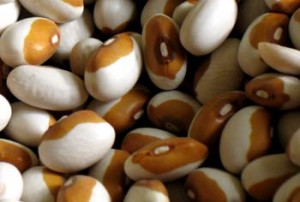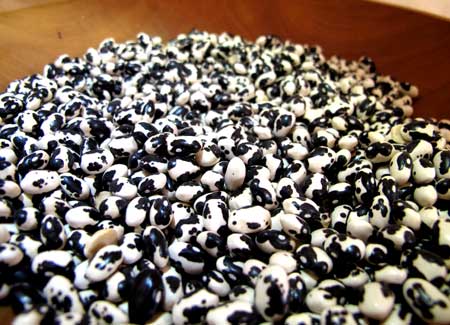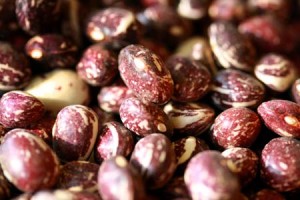Beano
Posted in Gardening Tips on April 10 2012, by Sonia Uyterhoeven
Sonia Uyterhoeven is the NYBG‘s Gardener for Public Education.

If you haven’t already gone out to buy your seeds for your vegetable garden, now is the time to do it. I have been reading Steve Sando’s ‘The Rancho Gordo Heirloom Bean Guide’ and would like to talk today about an overlooked topic: heirloom beans.
Some of you may sigh and think, “Oh, beans! Why doesn’t she talk about heirloom tomatoes or peppers?” But beans are one of the easiest things to grow in the vegetable garden; as legumes they are nitrogen fixers, so they don’t deplete the soil of nutrients, and they come in a delicious variety of mouthwatering flavors when you grow them from seed (I’m not kidding). Some are nutty, some are buttery, some are starchy, some are creamy and some are meaty.
For all you vegetarians and cuisine-conscientious souls out there, beans are also incredibly healthy. They are are full of protein and fiber. They are high in calcium but low in cholesterol, saturated fats and sodium. Beans help regulate blood pressure and blood sugar and are recommended for people with diabetes and hypertension. If this isn’t enough, they are also high in anti-oxidants and vitamin B.
From time to time I go to a trendy Vegan restaurant in New York City. It’s not my usual fare, but it’s fun to see how the other half lives. I usually get The Good Food Plate, which is a smorgasbord of different side dishes including tofu, braised greens, sweet potato and beans. The variety of beans that you find in restaurants and supermarkets typically consists of popular varieties such as black beans, kidney, pinto and garbanzo beans.
As you enter the world of heirloom beans, you will discover that the options are endless. Many heirloom beans, because they are freshly harvested, don’t need the extensive soaking time that store-bought, dried beans require. Sometimes you can even skip the soaking process entirely.

The bean family contains a number of genera. Popular heirloom beans in North America come from the genus Phaseolus. This genus includes several species. The common bean (Phaseolus vulgaris) is easy to grow. If you live in a hot, dry climate, look for tepary beans (Phaseolus acutifolius). Runner beans (Phaseolus coccineus) handle both cool and hot climates. This versatile species can be eaten when in flower, as a string bean, or as a shelling bean. Finally, there are lima beans (Phaseolus lunatus), with their half moon shape and buttery flavor.
Steve Sando highlights a number of his favorite beans both in his book and on his website, not to mention his blog. The majority of his top 50 beans are common beans (Phaseolus vulgaris). They include ‘Caballero’, ‘Classic Cranberry’, ‘Eye of the Goat’, ‘Eye of the Tiger’, ‘Good Mother Stallard’, ‘Moro’, ‘Rebosero’, ‘Snow Cap’ and ‘Yellow Eye’. Several of his preferred lima beans include ‘Balero Teopisca’, ‘Christmas Lima’ and ‘Florida Butter’. Two favorite runner beans are ‘Ayocote Morado’ and ‘Runner Cannellini’.
In the common bean category, ‘Caballero’ is one bean that he has placed in his top ten. It is a mild bean with the texture of heavy cream and the aroma of fresh vegetables. ‘Classic Cranberry’ has a thin skin and a nutty flavor, while ‘Eye of the Goat’–another all time favorite–melts in your mouth. ‘Good Mother Stallard’ is a versatile bean that makes a good pot bean, tastes wonderful with sautéed mushrooms, and makes a mean Mexican charro. ‘Moro’ works well in salads or soups and ‘Yellow Eye’ makes great baked beans.
For the lima bean lineup, ‘Balero Teopisca’ is a small bean with a buttery flavor that cooks quickly, while ‘Florida Butter’ is dense and creamy with a vegetable-like taste. The runner bean ‘Ayocote Morado’ can be used in salads, soups and chili con carne, and ‘Runner Cannellini’ (not to be confused with ordinary cannellini beans) has a rich, buttery taste and texture. It can be served with a bitter green such as cooked kale and tomatoes or thrown into a salad with red onion and canned tuna.

Beans are easy to grow, too. They like full sun and lots of water. Amend your soil with compost or composted manure so that it holds moisture and nutrients. If you are harvesting them young when they are string beans, go out on a daily basis and harvest handfuls. If you are interested in shelling beans (dried), wait until the seed pods mature. Cut back on your watering and let the plants slowly die. The pods will start to dry and become brittle.
When they’re ready, open up a pod and peek inside. Depending on the variety, the seeds come in wonderful patterns and colors from the brown and white of an Appaloosa horse, to midnight black, to all types of strange mottling in cranberry, yellow, pink and cream. The easiest way to take beans out of their pods, according to the growers, is to place the pods in a pillow case and either smash it against your home a few times or use it as a piñata. Just be sure to take stock of your surroundings before you start swinging.
Steve Sando recommends soaking your dried beans for two to six hours before you cook. Sauté finely chopped vegetables such as onion, carrot, celery and garlic in a cast iron pan. Add beans and cover with one inch of water if pre-soaked and two if not soaked. Bring pot to a boil for five to 15 minutes and then lower the heat and simmer until the beans are done–between one and three hours. The lid can stay on or off–whichever facilitates the simmer best.
Don’t worry about standing over the pot, either. Occasionally check the water level, but aside from that you can relax and read a book or start another project while the beans cook. If you lack recipes, the Rancho Gordo website has a few proven winners, as well as a video on how to prepare your beans. Be bold this year in your choice of beans and your family will thank you for it.
Photos courtesy of Rancho Gordo.


Let’s not forget that as purely aesthetic objects, some of these bean varieties are stunningly beautiful, too.
Pythagoras has much to answer for.